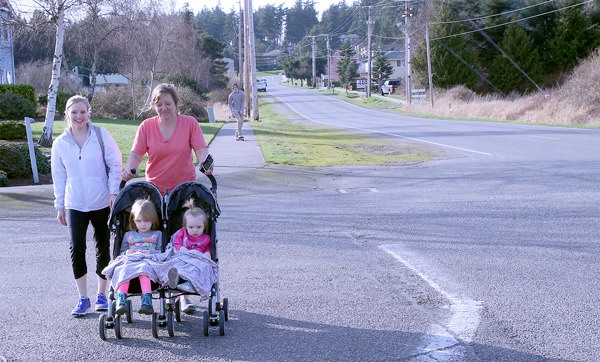A change in road construction priorities in Oak Harbor may bring relief someday to those who drive or walk along one of the city’s meanest streets.
And a long-planned-for extension of Bayshore Drive may be dead.
The improvements to Northeast Seventh Avenue can’t come soon enough for Deborah Wallin and daughter, Andrea Horner, who pushed a double-stroller with two babies down the road Thursday afternoon.
Much of the busy road doesn’t have sidewalks, and blackberry bushes intrude into a dusty trail popular with kids.
Walking along the road can feel downright dangerous.
“If a car is parked there, we have to go into the road,” Wallin said, pointing to an area without sidewalks.
Fixing Northeast Seventh Avenue, which runs in front of the Greenhouse Florist and Nursery, tops a draft list of priorities for street improvements that were presented to the Oak Harbor City Council this week during a workshop.
The preliminary list was developed by city staff and a consultant team, along with community input, through an extensive and ongoing update to the comprehensive plan — the document that governs growth and development.
“We got a lot of response from the public,” said Arnie Peterschmidt, the city’s project engineer. “A lot of interest and a lot of comments.”
Senior Planner Dennis Lefevre echoed the sentiments, pointing out that many residents were reached through workshops, an online survey and at events like farmers markets.
The “top tier” transportation projects are broken into the top 10 street improvements, pedestrian improvements and bicycle improvements.
A proposed expansion of Bayshore Drive along the north edge of Windjammer Park to Beeksma Drive didn’t make the cut. In fact, it ranked nearly at the bottom of 50 transportation projects that were considered and then winnowed.
Just last year, the Bayshore extension was near the top of the city’s Six-Year Transportation Improvement Program, while the Northeast Seventh Avenue project wasn’t even on the list. The six-year program, updated annually, is essentially the plan to implement the transportation element from the comp plan; inclusion in the program makes it much more likely that the city would obtain grant funding for a project.
Several community members and a couple of councilmen expressed concerns about the six-year plan before it was adopted, arguing that extending Bayshore was a bad idea and fixing Northeast Seventh Avenue should be the city’s top transportation priority. Councilman Jim Campbell voted against the six-year program because of the concerns.
This year’s six-year program will reflect the change in priority, Peterschmidt said. It will likely list Northeast Seventh Avenue as a top priority and remove the Bayshore extension altogether.
Northeast Seventh Avenue has also been on the city’s radar for a long time and was in the six-year program in the past. Peterschmidt said the main concern is the lack of sidewalks along the pedestrian-heavy stretch of road.
The city obtained grants for the project and planned to do it when ancient human remains were unearthed during the Pioneer Way project in 2011.
As a result, the city ended up spending millions of dollars on archaeology services and other mitigation and no longer had the matching funds to do the project.
“We weren’t able to pursue it until we got back onto our feet in terms of arterial street projects,” Peterschmidt said.
As for the Bayshore extension, the project has been in city plans for years. Originally, it was conceived as an alternate to the congested stretch of Highway 20 in front of Walmart.
More recently, city leaders discussed the possibility of building the extension in conjunction with the construction of the sewage treatment plant. Some council members proposed that the project would improve the economy and the park by creating access on the south side of some Pioneer Way properties, where new businesses could be built.
Peterschmidt said the growth projections that spurred the plans for the extension didn’t happen. Traffic engineers agreed that it’s not necessary.
“It was shown that it’s not a vital link that we need going forward,” he said.
Citizens also voiced their support for the Northeast Seventh Avenue improvements. During a Feb. 3 workshop, residents overwhelmingly picked it as their top priority while the Bayshore extension got no love.
Other top street improvements on the list include several “road diets,” which is when a traditional lane of traffic is removed and turned into something else.
Lefevre explained that a road diet for Midway Boulevard, which is the second priority, might mean turning it into a two-way road and adding a center turn lane and bike lanes. A center turn lane would improve traffic flow because cars making left turns would no longer hold up other vehicles.
“Capacity would not be hindered at all,” he said.
In addition, the pedestrian improvements in the plan include new crosswalks, sidewalks and trails. Bicycle improvements include bikes lanes on streets throughout the city and “sharrows,” which are markings on the street.
The next step, Peterschmidt said, is to come up with funding strategies to pay for some of the projects. He said a project on Northeast Seventh Avenue is likely to be a few years away.



